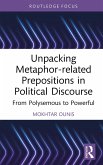Unpacking Metaphor-related Prepositions in Political Discourse (eBook, ePUB)
From Polysemous to Powerful


Alle Infos zum eBook verschenken

Unpacking Metaphor-related Prepositions in Political Discourse (eBook, ePUB)
From Polysemous to Powerful
- Format: ePub
- Merkliste
- Auf die Merkliste
- Bewerten Bewerten
- Teilen
- Produkt teilen
- Produkterinnerung
- Produkterinnerung

Hier können Sie sich einloggen

Bitte loggen Sie sich zunächst in Ihr Kundenkonto ein oder registrieren Sie sich bei bücher.de, um das eBook-Abo tolino select nutzen zu können.
This book explores the context around why English prepositions are used in figurative language more frequently than nouns and verbs, using corpus-based evidence to examine the most often used prepositions and how they are employed and for what purpose.
While research on cognitive approaches to metaphor has significantly expanded in recent decades, little attention has been paid to prepositions as vehicles of figurative language, owing to their polysemous, complex, and inconsistent nature. To bridge this gap, Ounis introduces an innovative conceptual framework that integrates conceptual…mehr
- Geräte: eReader
- mit Kopierschutz
- eBook Hilfe
![Unpacking Metaphor-related Prepositions in Political Discourse (eBook, PDF) Unpacking Metaphor-related Prepositions in Political Discourse (eBook, PDF)]() Mokhtar OunisUnpacking Metaphor-related Prepositions in Political Discourse (eBook, PDF)21,95 €
Mokhtar OunisUnpacking Metaphor-related Prepositions in Political Discourse (eBook, PDF)21,95 €![Language and Power (eBook, ePUB) Language and Power (eBook, ePUB)]() Paul SimpsonLanguage and Power (eBook, ePUB)38,95 €
Paul SimpsonLanguage and Power (eBook, ePUB)38,95 €![Appraisal, Sentiment and Emotion Analysis in Political Discourse (eBook, ePUB) Appraisal, Sentiment and Emotion Analysis in Political Discourse (eBook, ePUB)]() Claudia Roberta CombeiAppraisal, Sentiment and Emotion Analysis in Political Discourse (eBook, ePUB)42,95 €
Claudia Roberta CombeiAppraisal, Sentiment and Emotion Analysis in Political Discourse (eBook, ePUB)42,95 €![Systemic Functional Linguistics (eBook, ePUB) Systemic Functional Linguistics (eBook, ePUB)]() Christian M. I. M. MatthiessenSystemic Functional Linguistics (eBook, ePUB)35,95 €
Christian M. I. M. MatthiessenSystemic Functional Linguistics (eBook, ePUB)35,95 €![Introducing Pragmatics (eBook, ePUB) Introducing Pragmatics (eBook, ePUB)]() Louise CummingsIntroducing Pragmatics (eBook, ePUB)38,95 €
Louise CummingsIntroducing Pragmatics (eBook, ePUB)38,95 €![Meaning (eBook, ePUB) Meaning (eBook, ePUB)]() Betty J. BirnerMeaning (eBook, ePUB)34,95 €
Betty J. BirnerMeaning (eBook, ePUB)34,95 €![Politics, Lies and Conspiracy Theories (eBook, ePUB) Politics, Lies and Conspiracy Theories (eBook, ePUB)]() Marcel DanesiPolitics, Lies and Conspiracy Theories (eBook, ePUB)39,95 €
Marcel DanesiPolitics, Lies and Conspiracy Theories (eBook, ePUB)39,95 €-
-
While research on cognitive approaches to metaphor has significantly expanded in recent decades, little attention has been paid to prepositions as vehicles of figurative language, owing to their polysemous, complex, and inconsistent nature. To bridge this gap, Ounis introduces an innovative conceptual framework that integrates conceptual metaphor theory, diachronic linguistics, and discourse pragmatics. Drawing upon an extensive corpus of American presidential inaugural addresses, this book considers the linguistic, conceptual, pragmatic, and contextual dimensions of English prepositions, revealing the fascinating interplay between language, culture, and cognition.
This volume will be of interest to scholars in pragmatics, metaphor studies, English language, rhetoric studies, and historical linguistics.
Dieser Download kann aus rechtlichen Gründen nur mit Rechnungsadresse in A, B, BG, CY, CZ, D, DK, EW, E, FIN, F, GR, HR, H, IRL, I, LT, L, LR, M, NL, PL, P, R, S, SLO, SK ausgeliefert werden.
- Produktdetails
- Verlag: Taylor & Francis eBooks
- Seitenzahl: 118
- Erscheinungstermin: 27. November 2023
- Englisch
- ISBN-13: 9781003837909
- Artikelnr.: 69451324
- Verlag: Taylor & Francis eBooks
- Seitenzahl: 118
- Erscheinungstermin: 27. November 2023
- Englisch
- ISBN-13: 9781003837909
- Artikelnr.: 69451324
- Herstellerkennzeichnung Die Herstellerinformationen sind derzeit nicht verfügbar.
Preface
1. Chapter 1: Introduction
1.1. Defining key terms
1.2. Scope of this study
1.3. Structure of this book
2. Chapter 2: Navigating Prepositions
2.1. Defining prepositions
2.2. Polysemy: networks and principles
2.3. Cognitive grammar's view of prepositions
2.4. Prepositions' cognitive potential
2.5. Prepositions' contextual dynamics
2.6. Prepositions' axiological framing
3. Chapter 3: Metaphor: Insights from Classical and Cognitive Approaches
3.1. Classical views on metaphor
3.2. Cognitive view on metaphor
4. Chapter 4: The Power of Prepositions in Political Discourse
4.1. Political language
4.2. The history of political discourse analysis
4.3. The inaugural addresses and their generic properties
4.4. Conceptual metaphors in political discourse
4.5. The evolution trends of inaugural addresses
4.6. Metaphor variation and diachronic approach
5. Chapter 5: A Prepositional Portrait: Corpus and Frequency
5.1. Corpus linguistics and metaphor research
5.2. The Inaugural Corpus
5.3. The prepositions' frequency patterns
5.4. Tracking the preposition-to-word ratio
6. Chapter 6 Unpacking Metaphorical Patterns
6.1. Conceptual mappings of the metaphor-related prepositions
6.2. System metaphors and cross-system mapping
6.3. The coherence of metaphors
6.4. Prepositions and their metonymic basis
6.5. Conceptual notation revisited
7. Chapter 7: Beyond Spatial Metaphors
7.1. The cognitive model: an overview
7.2. Conceptual identity
7.3. Conceptual space
8. Chapter 8: Tracing Patterns of Change and Stability
8.1. Metaphor variations
8.2. Patterns of diachronic variations
9. Chapter 9: Concluding Remarks
9.1. How are prepositions distributedin the Inaugural Corpus?
9.2. What is the conceptual basis of metaphor-related prepositions?
9.3. How do metaphor-related prepositions mix?
9.4. Do metaphor-related prepositions reflect any systematic conceptualizations?
9.5. How do metaphor-related prepositions vary across history?
9.6. Final words
Index
Preface
1. Chapter 1: Introduction
1.1. Defining key terms
1.2. Scope of this study
1.3. Structure of this book
2. Chapter 2: Navigating Prepositions
2.1. Defining prepositions
2.2. Polysemy: networks and principles
2.3. Cognitive grammar's view of prepositions
2.4. Prepositions' cognitive potential
2.5. Prepositions' contextual dynamics
2.6. Prepositions' axiological framing
3. Chapter 3: Metaphor: Insights from Classical and Cognitive Approaches
3.1. Classical views on metaphor
3.2. Cognitive view on metaphor
4. Chapter 4: The Power of Prepositions in Political Discourse
4.1. Political language
4.2. The history of political discourse analysis
4.3. The inaugural addresses and their generic properties
4.4. Conceptual metaphors in political discourse
4.5. The evolution trends of inaugural addresses
4.6. Metaphor variation and diachronic approach
5. Chapter 5: A Prepositional Portrait: Corpus and Frequency
5.1. Corpus linguistics and metaphor research
5.2. The Inaugural Corpus
5.3. The prepositions' frequency patterns
5.4. Tracking the preposition-to-word ratio
6. Chapter 6 Unpacking Metaphorical Patterns
6.1. Conceptual mappings of the metaphor-related prepositions
6.2. System metaphors and cross-system mapping
6.3. The coherence of metaphors
6.4. Prepositions and their metonymic basis
6.5. Conceptual notation revisited
7. Chapter 7: Beyond Spatial Metaphors
7.1. The cognitive model: an overview
7.2. Conceptual identity
7.3. Conceptual space
8. Chapter 8: Tracing Patterns of Change and Stability
8.1. Metaphor variations
8.2. Patterns of diachronic variations
9. Chapter 9: Concluding Remarks
9.1. How are prepositions distributedin the Inaugural Corpus?
9.2. What is the conceptual basis of metaphor-related prepositions?
9.3. How do metaphor-related prepositions mix?
9.4. Do metaphor-related prepositions reflect any systematic
conceptualizations?
9.5. How do metaphor-related prepositions vary across history?
9.6. Final words
Index
Preface
1. Chapter 1: Introduction
1.1. Defining key terms
1.2. Scope of this study
1.3. Structure of this book
2. Chapter 2: Navigating Prepositions
2.1. Defining prepositions
2.2. Polysemy: networks and principles
2.3. Cognitive grammar's view of prepositions
2.4. Prepositions' cognitive potential
2.5. Prepositions' contextual dynamics
2.6. Prepositions' axiological framing
3. Chapter 3: Metaphor: Insights from Classical and Cognitive Approaches
3.1. Classical views on metaphor
3.2. Cognitive view on metaphor
4. Chapter 4: The Power of Prepositions in Political Discourse
4.1. Political language
4.2. The history of political discourse analysis
4.3. The inaugural addresses and their generic properties
4.4. Conceptual metaphors in political discourse
4.5. The evolution trends of inaugural addresses
4.6. Metaphor variation and diachronic approach
5. Chapter 5: A Prepositional Portrait: Corpus and Frequency
5.1. Corpus linguistics and metaphor research
5.2. The Inaugural Corpus
5.3. The prepositions' frequency patterns
5.4. Tracking the preposition-to-word ratio
6. Chapter 6 Unpacking Metaphorical Patterns
6.1. Conceptual mappings of the metaphor-related prepositions
6.2. System metaphors and cross-system mapping
6.3. The coherence of metaphors
6.4. Prepositions and their metonymic basis
6.5. Conceptual notation revisited
7. Chapter 7: Beyond Spatial Metaphors
7.1. The cognitive model: an overview
7.2. Conceptual identity
7.3. Conceptual space
8. Chapter 8: Tracing Patterns of Change and Stability
8.1. Metaphor variations
8.2. Patterns of diachronic variations
9. Chapter 9: Concluding Remarks
9.1. How are prepositions distributedin the Inaugural Corpus?
9.2. What is the conceptual basis of metaphor-related prepositions?
9.3. How do metaphor-related prepositions mix?
9.4. Do metaphor-related prepositions reflect any systematic conceptualizations?
9.5. How do metaphor-related prepositions vary across history?
9.6. Final words
Index
Preface
1. Chapter 1: Introduction
1.1. Defining key terms
1.2. Scope of this study
1.3. Structure of this book
2. Chapter 2: Navigating Prepositions
2.1. Defining prepositions
2.2. Polysemy: networks and principles
2.3. Cognitive grammar's view of prepositions
2.4. Prepositions' cognitive potential
2.5. Prepositions' contextual dynamics
2.6. Prepositions' axiological framing
3. Chapter 3: Metaphor: Insights from Classical and Cognitive Approaches
3.1. Classical views on metaphor
3.2. Cognitive view on metaphor
4. Chapter 4: The Power of Prepositions in Political Discourse
4.1. Political language
4.2. The history of political discourse analysis
4.3. The inaugural addresses and their generic properties
4.4. Conceptual metaphors in political discourse
4.5. The evolution trends of inaugural addresses
4.6. Metaphor variation and diachronic approach
5. Chapter 5: A Prepositional Portrait: Corpus and Frequency
5.1. Corpus linguistics and metaphor research
5.2. The Inaugural Corpus
5.3. The prepositions' frequency patterns
5.4. Tracking the preposition-to-word ratio
6. Chapter 6 Unpacking Metaphorical Patterns
6.1. Conceptual mappings of the metaphor-related prepositions
6.2. System metaphors and cross-system mapping
6.3. The coherence of metaphors
6.4. Prepositions and their metonymic basis
6.5. Conceptual notation revisited
7. Chapter 7: Beyond Spatial Metaphors
7.1. The cognitive model: an overview
7.2. Conceptual identity
7.3. Conceptual space
8. Chapter 8: Tracing Patterns of Change and Stability
8.1. Metaphor variations
8.2. Patterns of diachronic variations
9. Chapter 9: Concluding Remarks
9.1. How are prepositions distributedin the Inaugural Corpus?
9.2. What is the conceptual basis of metaphor-related prepositions?
9.3. How do metaphor-related prepositions mix?
9.4. Do metaphor-related prepositions reflect any systematic
conceptualizations?
9.5. How do metaphor-related prepositions vary across history?
9.6. Final words
Index







